Discovery of Hod and Valhall

Keeping tabs
The story is told by Asbjørn Tansø, who joined Amoco as an engineer in October 1972 when the company’s head office was still in Oslo and the base was at Tananger near Stavanger.
He was the only engineer at the latter facility, while the rest of the engineering staff were in the capital. The other base staff were operations manager Ed Sigurdson from the USA, a warehouse supervisor called Steve Kennedy, warehouse workers Kjell Nesheim and Gunnar Lauvsnes, and secretary Anne Meling.[REMOVE]Fotnote: Asbjørn Tansø, interview with Trude Meland, 4 November 2013; Rasen, Bjørn (2007): LF6A. Valhall at 25 … and it’s only the beginning, 68.
In order to learn as much as possible about where and how hydrocarbons were to be found, it was advantageous to supplement seismic data with the maximum amount of information about what the other oil companies were up to.
The team at the Tananger base accordingly chartered a fishing boat and upgraded its radio equipment a little so that it could lie at some distance from Ekofisk, for example, and eavesdrop on radio traffic about Phillips’ activities out there.
All contact with land went via Norway’s Rogaland Radio station, with open transmission which anyone could monitor. Amoco’s “espionage” reports also passed through Rogaland Radio, but were coded for security. An ex CIA agent in the company ensured that the alphanumerical codes were changed daily.
One day when a report was to be sent from the fishing boat, Tansø was seasick and allowed his colleague, geologist Charlie Ruble, to do the job instead. But he gave his name when making the call, and everyone in the small geological community realised that reports were being sent ashore by Amoco.
The boat was quickly called up by the rig’s parent company with orders to leave the area immediately or the authorities would be informed.
“The head of the exploration department [Bill Shaw] was very irritated that we could stoop to such behaviour in Amoco,” Tansø recalls.[REMOVE]Fotnote: Rasen, Bjørn (2007): LF6A. Valhall at 25 … and it’s only the beginning, 217.
Instead, he began flying over the North Sea to observe. In early 1973, he was flown repeatedly over the northern part of this area to observe drilling rigs operating between Bergen-Shetland-Aberdeen-Bergen, check on activity and see whether anyone had found oil.
This was a matter of monitoring what the other companies were doing, if they were producing through test separators and whether anyone had a test flare.
The last of these could provide a lot of information. A long flame meant high pressure, and its colour could show whether oil or gas was being burnt, for instance. Some crew are said to have heard the plane and incinerated refuse in a bid to fool it.
Furthermore, Tansø could estimate the depth being drilled to by photographing the number of drill pipes stacked up on deck and counting them afterwards.
Although Tansø suffered from vertigo, this did not apply in planes. He initially hired a single-engine machine and sat with the pilot in the cockpit while they flew around.
They were halfway home on one occasion when the engine began to stutter. That was a little frightening, but the pilot got things going again. He had simply forgotten to switch over to the other fuel tank.
A twin-engine plane was used thereafter. Tansø is unable to say whether the observations he made benefitted the company.[REMOVE]Fotnote: Rasen, Bjørn (2007): LF6A. Valhall at 25 … and it’s only the beginning, 217.
Life on a rig
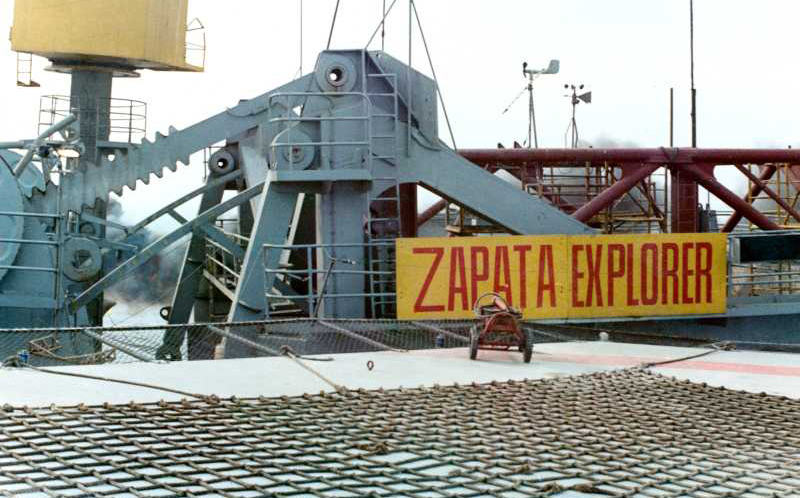 Funnet av Hod og Valhall,
Funnet av Hod og Valhall,Tansø also went offshore on the Zapata Explorer jack-up rig to learn and to get his hands dirty. As an engineer, it was important for him to be familiar with the whole exploration process.
The drilling superintendent, who worked for Amoco, was the ultimate authority on the rig, and company engineers were always present when wells were being tested. Otherwise, Amoco tool pushers Don Draper and Neil Larsen worked alternate tours offshore.
Draper was a bit of a character, Tansø recalls. He had grown up on oil fields around the USA, and followed in his father’s footprints as a driller.
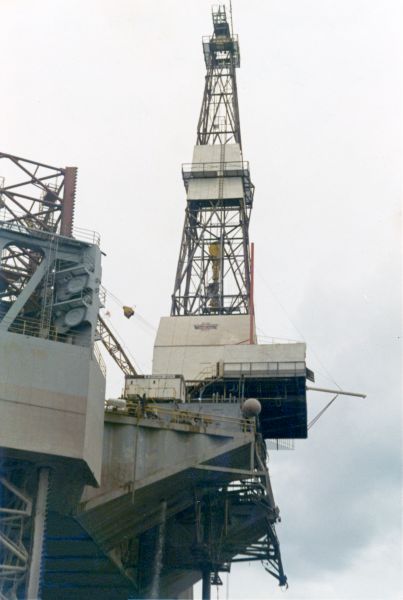 Funnet av Hod og Valhall,
Funnet av Hod og Valhall,This occupation was neither particularly lucrative or well-regarded in America, and Draper himself had no education and could not even write. But he knew drilling – it was in his blood.
The methods he used to get the work done as he wanted it were not always entirely acceptable. When he thought a worn bit needed replacing, for example, the managers on land did not always agree with him.
They were responsible for the financial aspects, and pulling out all the drill pipe in order to replace the bit took a long time. Day rates for a drilling rig were very high.
If his recommendation was refused, Draper himself might stage a little accident – such as pushing in a glove when the next length of pipe was to be run.
The glove disappeared down the string with the circulating mud until it ran into the bit and the whole operation came to a halt. So the bit had to be changed anyway. But that was not all. In addition, Draper called the land organisation to complain that somebody had dropped a glove inside the string and cursed a little.
On one occasion, the person who got the blame was sent straight back to the USA. Draper’s own career in Amoco Norway lasted 18 months.[REMOVE]Fotnote: Asbjørn Tansø, interview with Trude Meland, 4 November 2013.
The drilling crew were largely Danes. Those doing cementing worked for Halliburton, while logging was carried out by Schlumberger. A total of 50-60 people belonged to the offshore team.
As on the fishing boat, code was used for communication with land. Messages were phoned via Rogaland Radio at specific times. But sending and receiving in code was not easy for Draper, who was illiterate. Tansø sat beside him and whispered what he should say, but the message came back: “I can hear you, Tansø”.
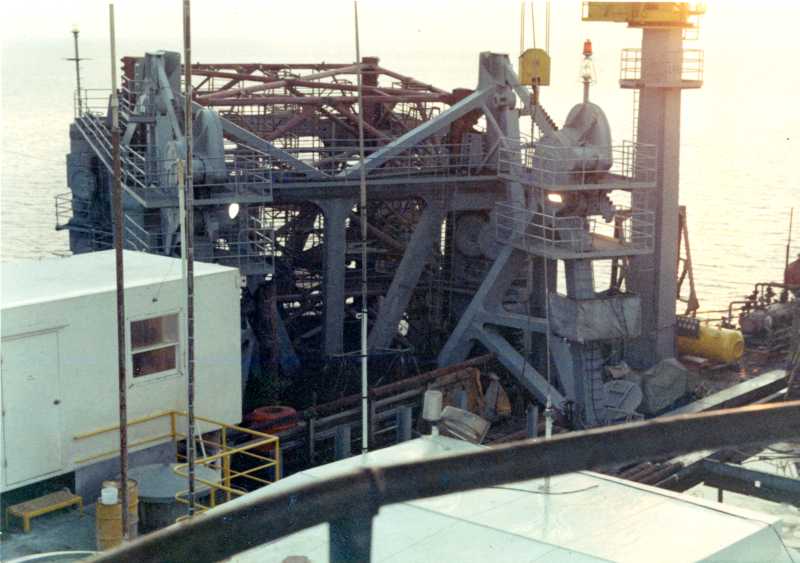 Funnet av Hod og Valhall,
Funnet av Hod og Valhall,Life on the rig was basic and tough, with eight-berth cabins and no women on board – which was reflected in the grubby condition of the men. Drilling was a dirty business.
The work was physically demanding, since it relied on mechanical tools such as tongs, chain and winches for screwing and unscrewing lengths of drill pipe.
A length of chain was thrown to wrap around the drill pipe to speed up the job of making up (joining) or breaking out (separating) the drill string. That was the easy part. Tongs were then needed to screw/unscrew the pipe in the box connection.
Most of the roughnecks (drill floor workers) were powerful fellows, who often lacked a finger which had been crushed during the work.[REMOVE]
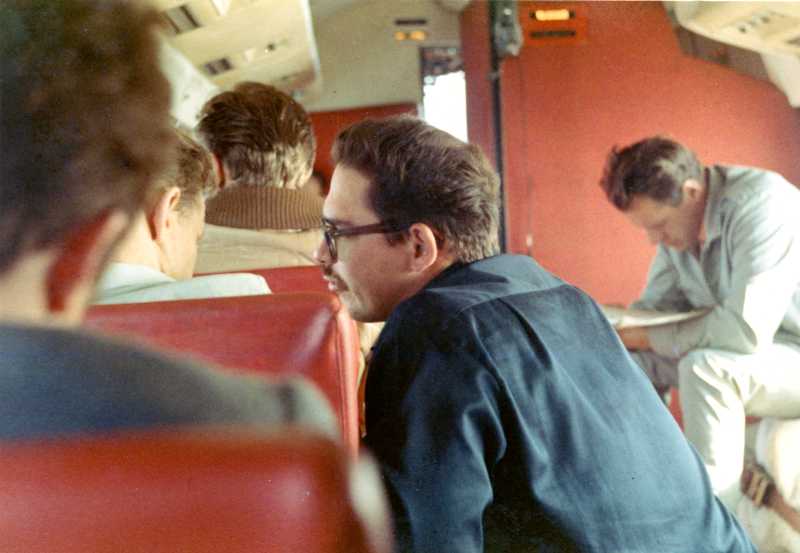 Funnet av Hod og Valhall,
Funnet av Hod og Valhall,Fotnote: Asbjørn Tansø, interview with Trude Meland, 4 November 2013.
Drilling strategy
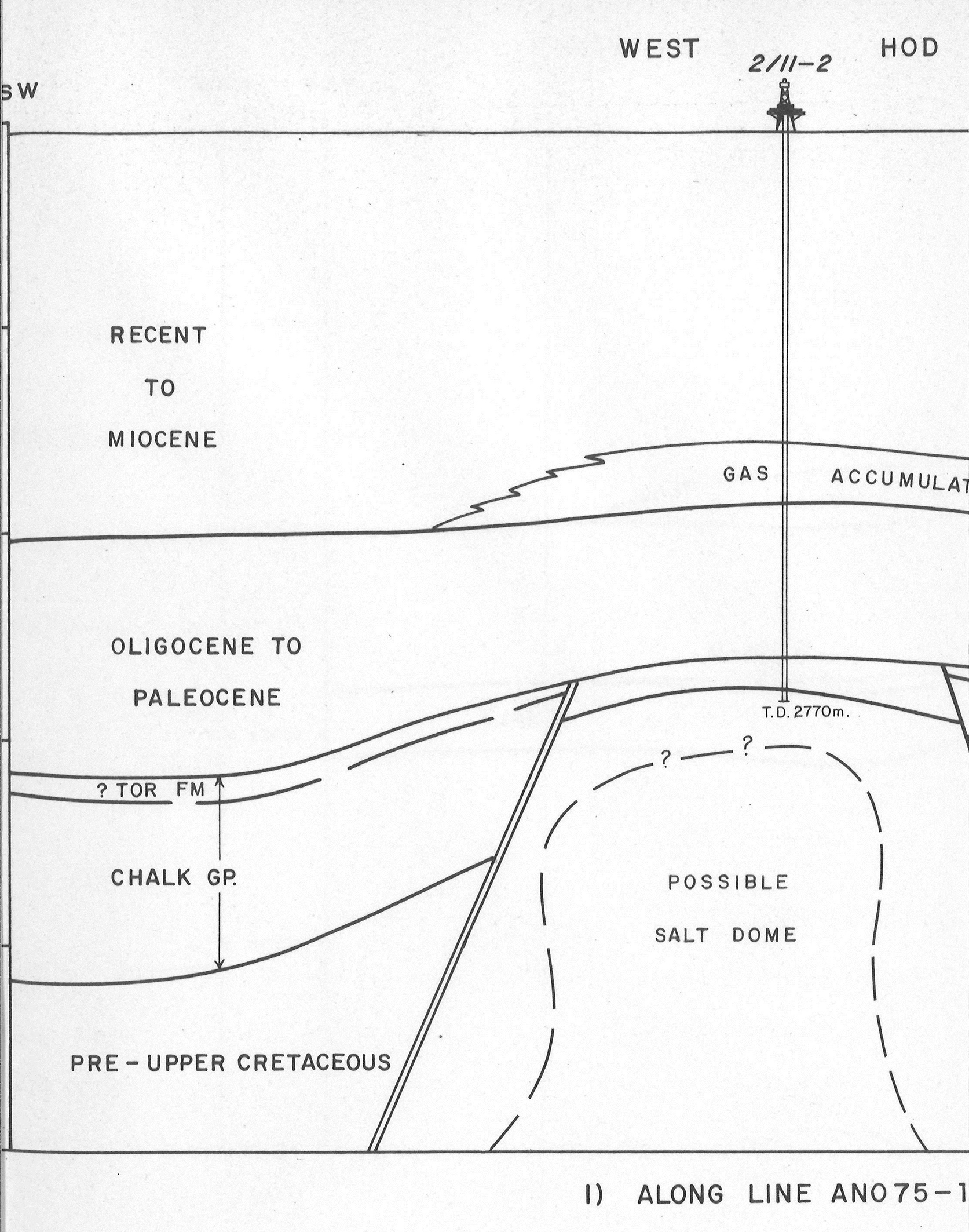 Funnet av Hod og Valhall,
Funnet av Hod og Valhall,The big question was where further wells were to be drilled. Seismic surveys had revealed interesting structures in blocks 2/8 and 2/11. But the seismic maps of the former (where Valhall would be found) provided some images which were difficult to interpret.
Oil appeared to be present across a relatively large area, but looked as if it lay in a doughnut-shaped formation – a ring with a hole in the middle.
This was initially interpreted as a salt dome which had penetrated the oil-bearing chalk stratum. If this meant the oil had migrated from the central area, there might not be much left.
In reality, what the geologists call a gas cloud had accumulated at a depth of 1 500 metres in a pocket above the oil layer. This delayed the seismic echoes so that only the outer edge of the field could be seen.
A third well was drilled in 2/8 in order to investigate the structure more thoroughly, but was unsuccessful – it found only water.
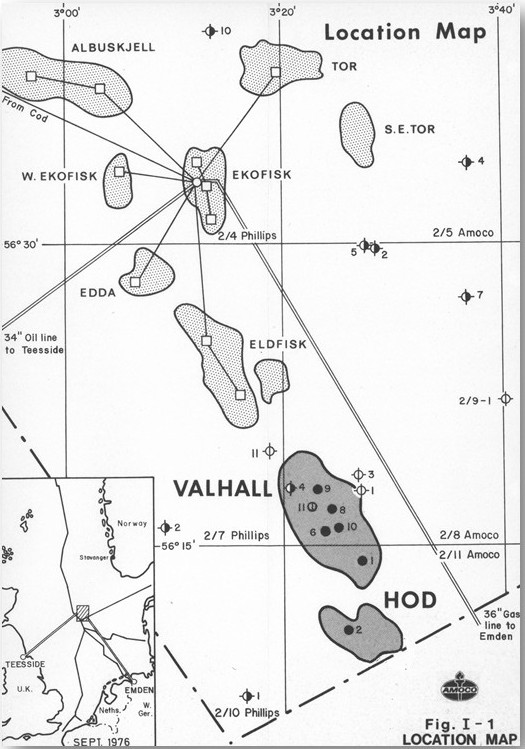 Funnet av Hod og Valhall,
Funnet av Hod og Valhall,The geologists began to acquire a better understanding of the gas cloud, and decided to drill once again in 2/11. After all, Amoco had found hydrocarbons in the carbonate reservoir with well 2/11-1 in 1969. Encouraged by the Ekofisk and Tor discoveries, however, exploration continued on Valhall and a fourth well in 1973 encountered hydrocarbons.
After Ekofisk had come on stream from a similar structure, Amoco began to have more faith in its own block. (Read more about the special properties of Valhall and Hod’s carbonate reservoirs in the article on Valhall’s geology.)
The “doughnut” effect was not so prominent on the geological maps in 2/11, since the oil beneath the gas cloud had accumulated behind a fault.
Well 2/11-2 was accordingly spudded on the outer edge of the gas cloud, and Hod was proven in December 1974. Surprisingly, the carbonate reservoir lay 185 metres higher than expected.
Results from the well were published in a report dated December 1975.[REMOVE]Fotnote: Amoco Norway Oil Company, Valhall Area Scoping Reservoir Studies , December 1975. This described the permeability and porosity properties of the Hod reservoir.
It was already clear that the chalk would not be easy to deal with. But this rock was much less of a problem than it would prove to be on Valhall. But the experience Amoco had gained was equally important, since it emboldened the company to drill along the “doughnut” in 2/8.
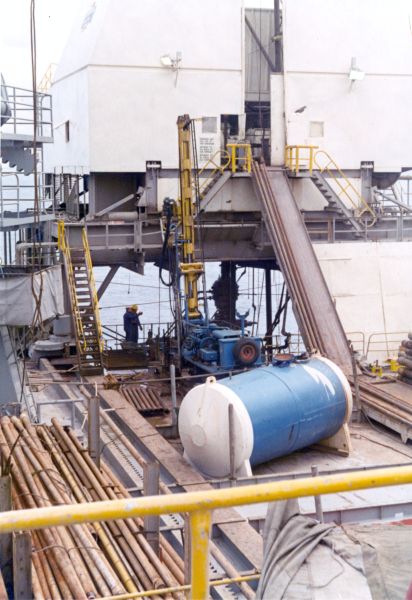 Funnet av Hod og Valhall,
Funnet av Hod og Valhall,Rune Skeie, who had recently graduated as a petroleum engineer from Stavanger’s Rogaland Regional College was on the platform when the discovery was made. The discovery well was spudded fromWaage Drill on 7 April 1975, with the reservoir reached on 10 June.[REMOVE]Fotnote: Øyvind Kvaal, articles in Amoco Viking , “A large anticlinal structure”. Valhall was proven midway between two earlier wells.
“We were very optimistic and in a good mood when we saw the thickness of the oil layer in the well,” he reported. “But when testing began and we stimulated the well, the test pipe was blocked with a chalk plug. Valhall produced chalk from day one, that’s for sure.[REMOVE]Fotnote: Øyvind Kvaal, articles in Amoco Viking , “A large anticlinal structure”.
By chance, everyone from the accounts department was on a trip out to the rig at this time to become more familiar with what went on offshore. Their helicopter flight home was delayed by a storm, so they had to stay for a few extra days.
Controller Sigmund Rosnes remembers the discovery and that he and his colleagues did not quite appreciate its significance. Everyone was pleased, but no big celebrations happened on board.[REMOVE]Fotnote: Øyvind Kvaal, articles in Amoco Viking , “A large anticlinal structure”.
From discovery to development with HodDeveloping the Valhall centre
